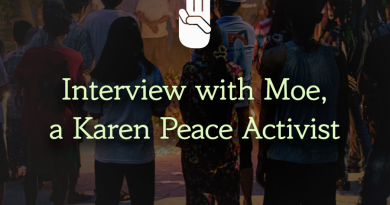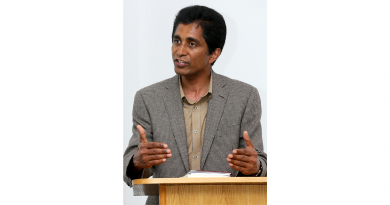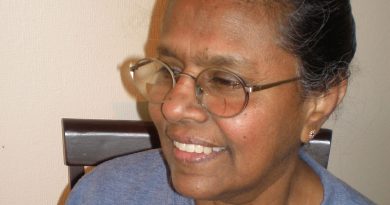In Search for Just Peace in Sri Lanka
My Journey of Crossing the Borders
It was July 1983. I had just finished my secondary level education and was about to start my university life. Hundreds of Tamils were massacred. Women were raped. Houses and properties were looted and set on fire. All these were done by the racist members of the Sinhala community to which I belong. Sri Lankan police and the security forces gave a free hand to the perpetrators to commit these crimes. The state gave them total impunity. The Sinhala society justified this mass atrocity as a retaliation to the killing of 13 Sri Lankan (Sinhala) soldiers by the Liberation Tigers of Tamil Eelam (LTTE) in that month. The LTTE had started to campaign demanding a separate state for the north and east of the island. I was taught throughout my education that my country has to be one single state and it belongs to the Sinhalese and part of it cannot be given to the Tamils. We Sinhalese are the true inheritors of the whole island. The Tamils are invaders. I could not understand why the Tamils were asking for a separate state, but I could not bear the mass atrocities committed against them by the members of my Sinhala community. July 1983 deeply troubled my conscience. What could I do as a young man? I decided to learn Tamil. This was my first step of crossing the border; the language barrier.
The Sri Lankan state declared war against the Tamils and promised that the Tamil rebels will be anihilated within weeks. The Sinhala news was filled with military successes of destroying the rebels. I believed what the state media said, but my deep pain casued by July 1983 did not go away. I started making personal contacts with some Tamil students who were studying in my university. They had come from the north and east. This was my second step of crossing the border; making personal contacts. Their stories were totally different from what the state media said. Thousands of Tamils have been arrested. Some have been made to disappear. Some are tortured. Entire villages have been heaviliy militarised. There are many Tamil youth joining the LTTE to resist the Sri Lankan state. I took my next step. By the end of 1980s I crossed the physical border between the Sinhala South and Tamil North to see the reality without telling even my parents and teachers. It was also during this period that thousands of Sinhala youth were killed by the Sri Lankan state in repressing the armed uprising in the Sinhala South which demanded social and economic justice.
I have crosssed the physical border numerous times nearly for 15 years both in the height of war and peace. I saw how the enormous suffering Tamil people went through in the region without basic food, medicine and shelter. Thousands were displaced many times. I spoke about this reality in the Sinhala South and spoke in the Tamils region about the massacre of the Sinhala youth by the Sri Lankan state. I did this with the intension of building a common resistance to the oppressive state. I managed to mobilize some Sinhala groups to organise humanitarian aid to the Tamil region. This was an attempt not only to cross the border, but to build a bridge between the two communities. However, the Sri Lankan state’s racist military campaign was so powerful that a majority of Sinhalese believed that the war can be won despite massive destruction. Even the Sinhala political party that led the uprising against the Sri Lankan state wholeheatedly supported the war drive totally forgetting the memory of the massacres they experienced. It was at this point I really crossed the idelogical border. The reason for the Tamil demand for the independenace is nothing but the Sinhala oppressive state. I was willing to give up the ‘Sinhala state’ for the sake of just peace.
Since the 1990s the LTTE managed to control vast areas of the Tamil region. It was a state within a state where there was a well organised civil administration with a range of welfare systems. The Tamils simply did not stay as victims, but they built a state of their own which is secular. It is not a religious state like the Sinhala Buddhist Sri Lankan state. It was their reistance to oppression and resilience amidts destruction that gave rise to this state. I worked with a small group of Sinhala political analysts, journalists and activists who deeply studied the root causes of the Sri Lankan conflict. The British Empire formed the Sri Lankan unitary state system giving the power to the Sinhalese and making them belive that they are racially supeiror to the Tamils. The main reason to do so was to maintain the island as one single unit because of its stragteic importance in the Indian Ocean. I took another step of my journey when I realised that the conflict is not simply a local one. It is a geopolitical one. I joined my Sinhala and Tamils friends to conduct education programmes throughout the Sinhala South that exposed this geopolitical aspect of the conflict.
In 2002, both the Sri Lankan state and the LTTE entered into a peace process. For the first time in history there was a recognition that there should be a political solution. This means transforming the oppressive Sri Lankan state sturcture and accepting the Tamil state through a mutual agreement. I and my collegues organsied a massive Tamil-Sinhala Tamil cultural event gathering over 600 Tamils and Sinhalese to highlight the commonalities and differences in the historical stuggles of the two communities. However the USA and UK opposed a negotiated political solution that shared power with the LTTE and supported the Sri Lankan state economically, diplomatically, politically and militarily. As a result the war started which killed nearly 70,000 Tamils and destroyed the entire Tamil state with all of its top leaders. Many of my close friends were killed. I was forced to leave the country before the war ended. Many other friends who worked with me too left. I chose Ireland to live in exile. Why Ireland? The Irish people like the Tamils have resisted colonial rule and later entered into a peace process to share power in Northern Ireland. This gave me hope to live.
The world powers who backed the war deliberately hid the truth about the massacre and the truth about the peace process. The most important step I and my friends who went into exile did was organisng of the Peoples’ Tribunal on Sri Lanka in Dublin and Bremen. This was mainly organised by the Sinhala activists with the support of the Irish and German human rights campaigners. We succeeded in gathering a large number of Tamils who fled the war to give evidence at the Tribunal. The judges found the Sri Lankan state and its security forces guilty of genocide and the USA and UK compilicit in genocide by supporting the Sri Lankan state against the LTTE. The Tribunal recognised the Tamil’s right to self-determination in their homeland as a human right. This was a moment of deep reconciliation between the Tamils and the Sinhala activists, but it happened not in Sri Lanka, but outside. In Sri Lanka, the state uses the word reconciliation asking the Tamils to forget the past and demanding them to accept heavy militarization, land grab, building of Sinhala Buddhist shrines in the Tamil region. The word reconciliation in this sense is a cover up of crimes. The true reconciliation can happen by seeking just peace as shown by the Tribunal.
I have lived in exile nearly for 15 years. I am taking another step of my journey of crossing the borders, that is to build solidarity with the people of Jeju, Okinawa, Kashmir, Palestine, South Africa, Colombia, Equador and of many other places who continue to resist global military powers and who demand just peace. It is by building horizontal solidaity across the borders that we can achive just peace. The journey of crossing the borders has not ended…
Jude Lal Fernando
Director of Trinity Centre for Post-Conflict Justice, University of Dublin
Coordinator of Peoples’ Tribunal on Sri Lanka



